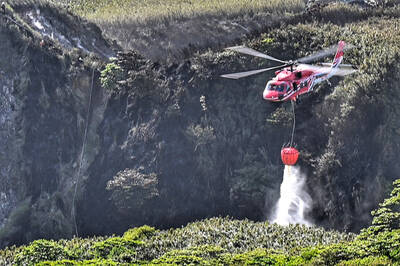A local company has unveiled the nation’s first indigenous unmanned aerial vehicle (UAV) for photography, hoping to break into a market that so far has been monopolized by imported products.
The AI Rider, a system based on a six-rotor UAV weighing about 1.45kg, is highly competitive because of its price and after-sales service, including a training program that is easily available to domestic customers, said Clark Lin, vice president of Gang Yu Corp.
After its introduction during Secutech, an international security exhibition being held in Taipei this week, importers from countries such as the US, Japan, Russia and Thailand have shown interest in becoming distributors, Lin said.
The remote-controlled aerial photography vehicle is said to be entirely developed in Taiwan and made with domestic components. It can carry a payload, such as a video camera, of up to 400g and can climb to an altitude of 550m.
It can withstand a sustained wind speed of up to 10m per second, or an instantaneous wind speed of no more than 15m per second.
With a fully charged battery, the drone can fly for up to 13 minutes with a 250g payload and can reach a 750m radius from its handler.
The company said the AI Rider is more competitively priced than imported products with similar specifications. Its price of US$25,000 is a seventh of the asking price for foreign imports.
The AI Rider has already been used by Taiwan’s military and academic institutions for surveillance and geographic surveying. Now, it can also be used for newsgathering, recreation and search and rescue operations.

Taiwan is stepping up plans to create self-sufficient supply chains for combat drones and increase foreign orders from the US to counter China’s numerical superiority, a defense official said on Saturday. Commenting on condition of anonymity, the official said the nation’s armed forces are in agreement with US Admiral Samuel Paparo’s assessment that Taiwan’s military must be prepared to turn the nation’s waters into a “hellscape” for the Chinese People’s Liberation Army (PLA). Paparo, the commander of the US Indo-Pacific Command, reiterated the concept during a Congressional hearing in Washington on Wednesday. He first coined the term in a security conference last

Prosecutors today declined to say who was questioned regarding alleged forgery on petitions to recall Democratic Progressive Party (DPP) legislators, after Chinese-language media earlier reported that members of the Chinese Nationalist Party (KMT) Youth League were brought in for questioning. The Ministry of Justice Investigation Bureau confirmed that two people had been questioned, but did not disclose any further information about the ongoing investigation. KMT Youth League members Lee Hsiao-liang (李孝亮) and Liu Szu-yin (劉思吟) — who are leading the effort to recall DPP caucus chief executive Rosalia Wu (吳思瑤) and Legislator Wu Pei-yi (吳沛憶) — both posted on Facebook saying: “I

Sung Chien-liang (宋建樑), who led efforts to recall Democratic Progressive Party (DPP) Legislator Lee Kun-cheng (李坤城), was released on bail of NT$80,000 today amid outcry over his decision to wear a Nazi armband to questioning the night before. Sung arrived at the New Taipei District Prosecutors’ Office for questioning in a recall petition forgery case last night wearing a red armband bearing a swastika, carrying a copy of Adolf Hitler’s Mein Kampf and giving a Nazi salute. Sung left the building at 1:15am without the armband and covering the book with his coat. Lee said today that this is a serious

A mountain blaze that broke out yesterday morning in Yangmingshan National Park was put out after five hours, following multi agency efforts involving dozens of fire trucks and helicopter water drops. The fire might have been sparked by an air quality sensor operated by the National Center for High-Performance Computing, one of the national-level laboratories under the National Applied Research Laboratories, Yangmingshan National Park Headquarters said. The Taipei City Fire Department said the fire, which broke out at about 11am yesterday near the mountainous Xiaoyoukeng (小油坑) Recreation Area was extinguished at 4:32pm. It had initially dispatched 72 personnel in four command vehicles, 16